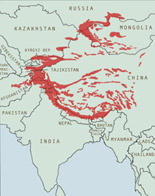History of snow leopards in zoos
The London Zoo was the first official zoo to have a snow leopard when it received one from Bhutan in 1891. By the early 1900’s New York, Berlin and Moscow also had snow leopards.

Snow leopard in cage at Bronx Zoo 1906. WCS Photo.
This photo from the Wildlife Conservation Society shows a snow leopard at Bronx Zoo in 1906. At this time all these animals would have been captured from the wild. We can imagine the lives of these animals would have been quite sad, not only the standard of their environment, that is being kept cages but also the lack of knowledge about how to look after them and feed them.
Today the quality of life for snow leopards in zoos has improved greatly. There’s been a lot of work to understand snow leopard behaviour. Medical treatment has also improved. And nowadays enclosures are bigger and better designed and have elements from wild snow leopard habitats. In the Zurich Zoo for instance, the snow leoaprds have a vertical rock face in their enclosure, very similar to a typical mountain rock face in their natural habitat.
In 1960 there were 22 captive snow leopards in Europe and North America but by 1976 the population had increased to 167, many of them wild caught animals. In the late 1970’s snow leopard breeding in zoos was more common but only about 50% of cubs survived to the age of six months. By the 1980’s knowledge of breeding techniques had improved and in 1983 there were 292 snow leopards in 73 zoos around the world. Between 1960 and 1984 there were 141 snow leopards taken from the wild, many of them from the Soviet Union (now Russia). Today it is estimated there are approximately 400 snow leopards in zoos around the world.
Today knowledge of behavior, feeding, mating etc is such that snow leopards breed successfully in zoos all over the world. Almost all cubs born are mother-reared, an indicator of good adaption to their zoo environment. Also Zoo’s no longer take snow leopards from the wild unless they are individuals that have been captured from poachers and hunters and can’t be returned to their natural environment.
While we all hope and work towards keeping the snow leopard alive in the wild zoo populations also have their role in helping to educate the public about conservation of this and other endangered animals.
Best practice Zoo snow leopard zoo enclosures and enrichment
Association Of Zoos Approved Enrichment Techniques from Zoo Design.
Hunting Enrichment
- Irregular shaped gourds
- Rattles with seeds inside
- Food on zip
- lines for motion
- Piñatas for working to get food
- Animal Decoys
Harvest Enrichment (Foraging Enrichment)
- Animal Carcasses for more realistic natural feeding. Idea is for the cats to get into the bone and get some meat and some marrow.
- “Puzzling out” where the Pray “feeding devices” are in the enclosure
Sensory Enrichment
- Scent: fresh herbs, spices, perfume, and even elephant dung enrich the cat’s noses! Snow Leopards enjoy about any scent they encounter.
- Sights and sounds to the zoo exhibit habitat
Habitat Enrichment
- Scent
- Climbing Tree
- Lookout Mounds
- Lair
- Logs
- Water areas
- Feeding areas using unique feeding devices
Snow leopard zoo care
Snow leopards in zoos live much longer than their wild counterparts. Zoo animals get more and better quality food than in the wild. They lack predators to harm and injure them and they get excellent medical care.
When cubs are born they get regular medical checkups and medical care,
But just like humans in old age, older zoo snow leopards can face health issues like arthritis, failing eyesight, cancer and kidney failure. In fact, zoo staff and scientists are still learning more about how to keep old snow leopards young as more and more of them thrive in well-designed exhibits throughout the world.
Today zoos have a team of people available to care for their ‘geriatric’ animals. Usually the keepers who work with snow leopards on a daily basis are the first to see signs of stiffness, soreness, slowing down, visible lumps etc. In most zoos the keepers call in the zoo veterinarian but they can also get help from other specialists like behavior experts, pathologists, dentists, ophthalmologists, cardiologists and geneticists.
This team then decides on the long-term health of the cat and what they think the quality of life will be. If the cat is still interested in food and its environment and enrichment activities, and has good mobility, the team may operate (for tumors for example) or treat with medications. For arthritis snow leopards are often given NSAIDs like Ibuprofen and they might also get Glucosamine and Chondroitin for joint health and perhaps steroid anti-inflammatories to manage pain.
Making helpful adaptions in the snow leopard’s home exhibit area can also help keep an old cat young. For example, a snow leopard with failing eyesight might get brighter lights so she can see better and move around more easily.



